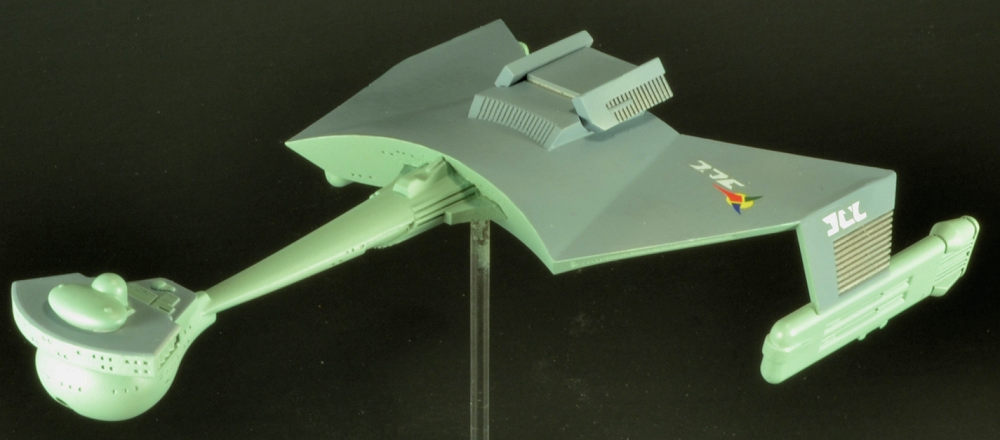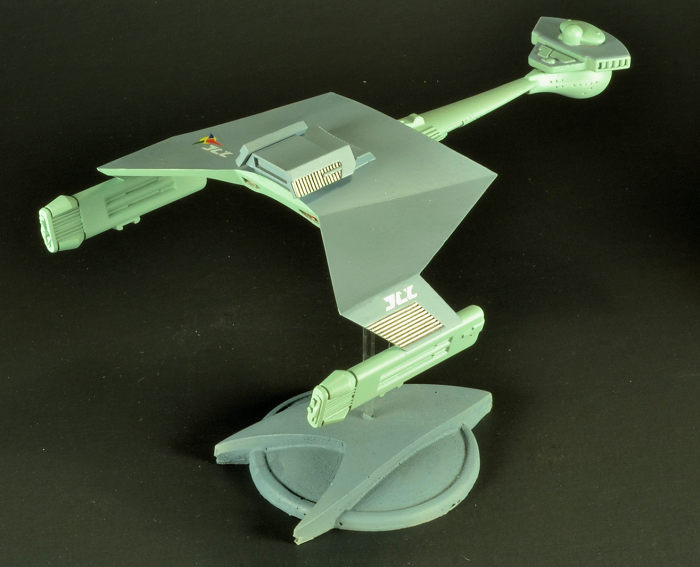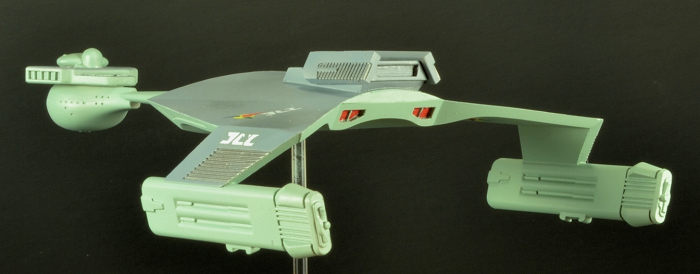
Alliance Models 1/1400 Klingon D-7 Battlecruiser
| KIT #: | 1057 |
| PRICE: | $35.00 |
| DECALS: | One option |
| REVIEWER: | Ben Brown |
| NOTES: | Resin with laser printed decals |

| HISTORY |
qo'vaD d-7 Segh may'Duj Dub Hom tlhIngan DaHjaj ta'be'nalwI' yo' qaStaHvIS tera' 23rd vatlh DIS. ngat neH 2256 tlhIngan-DIvI' veS 'ej Segh lo' neH 2268 romuluS Hov wo'. reH HIjwI'pu' ngu'laH ngaSwI' yuvtlhe' wIngaQmoHta'DI' d-7 Segh pong qItI'nga' Segh, tagh neH 2270s.
(Translation: The D-7 Class battlecruiser served as the backbone of the Klingon Imperial Fleet during Earth’s 23rd century. It was used during the 2256 Klingon-Federation War and the Romulan Star Empire began using the class around 2268. The D-7 class was eventually replaced by the upgraded K’Tinga class, beginning in the 2270s.)
 The D-7
battlecruiser used in the original Star Trek
series was designed by Matt Jeffries and made its first appearance in Season 3’s
The Enterprise Incident
(because someone stepped on and broke the Romulan warbird model). AMT was
contracted to make two filming models. The first model, painted overall gray,
was delivered to Paramount and AMT kept the second one to pantograph down to ½
the filming model’s size in order to produce a 1/650 model kit. Because of this,
AMT’s large D-7 kit is probably the most accurate of all the Star Trek models
they produced. Upon receiving the first model, Jeffries painted much of the hull
a light gray-green color. Once AMT had finished with the second model, it was
delivered to Paramount to act as a standby, in case the first was damaged, or in
case a second ship was needed for a scene. Jeffries painted this model to match
the first one. The second model was never used and sat in Gene Roddenberry’s
office until the series ended. The first D-7 model was donated to the
Smithsonian and the “Roddenberry Model” later changed hands several times before
being sold at auction in 2006. In the late 1970s, the first filming model was
taken back from the Smithsonian, to be used in the
Star Trek: Phase Two television series, and a third,
darker green was added to the model at this time. The series was eventually
cancelled in favor of a movie, Star Trek: The Motion
Picture. The model was too small to be used for the
large screen, so a mold was made of it for the studio to use to make a new
battlecruiser that was twice as large. The model was then repainted overall gray
and returned to the Smithsonian. The Roddenberry Model has remained in its
original green and gray pant scheme.
The D-7
battlecruiser used in the original Star Trek
series was designed by Matt Jeffries and made its first appearance in Season 3’s
The Enterprise Incident
(because someone stepped on and broke the Romulan warbird model). AMT was
contracted to make two filming models. The first model, painted overall gray,
was delivered to Paramount and AMT kept the second one to pantograph down to ½
the filming model’s size in order to produce a 1/650 model kit. Because of this,
AMT’s large D-7 kit is probably the most accurate of all the Star Trek models
they produced. Upon receiving the first model, Jeffries painted much of the hull
a light gray-green color. Once AMT had finished with the second model, it was
delivered to Paramount to act as a standby, in case the first was damaged, or in
case a second ship was needed for a scene. Jeffries painted this model to match
the first one. The second model was never used and sat in Gene Roddenberry’s
office until the series ended. The first D-7 model was donated to the
Smithsonian and the “Roddenberry Model” later changed hands several times before
being sold at auction in 2006. In the late 1970s, the first filming model was
taken back from the Smithsonian, to be used in the
Star Trek: Phase Two television series, and a third,
darker green was added to the model at this time. The series was eventually
cancelled in favor of a movie, Star Trek: The Motion
Picture. The model was too small to be used for the
large screen, so a mold was made of it for the studio to use to make a new
battlecruiser that was twice as large. The model was then repainted overall gray
and returned to the Smithsonian. The Roddenberry Model has remained in its
original green and gray pant scheme.
| THE KIT |
 The
Alliance Models D-7 is about 7 inches long, so it is a good option if you are
like me and don’t have room to display the Polar Lights 1/1000 kit or the AMT
1/650 kit. It is 1/1400 scale, which is a common scale for Star Trek resin kits.
It is beautifully designed and cast. I only found one tiny bubble to be filled
in any of the seven parts. The kit also includes a section of brass rod and
strangely, a Starfleet insignia for a stand. A small decal sheet is provided,
but no decal placement guide is included for the many small decals included on
the sheet. The kit is missing the two tractor beam emitters on the underside of
the bridge section and two plates on the grills on the main hulls. It also
includes K’Tinga-style impulse engine exhausts on the stern that are not present
on the filming models. We’ll just call this is a post-Original Series upgraded
version of the D-7.
The
Alliance Models D-7 is about 7 inches long, so it is a good option if you are
like me and don’t have room to display the Polar Lights 1/1000 kit or the AMT
1/650 kit. It is 1/1400 scale, which is a common scale for Star Trek resin kits.
It is beautifully designed and cast. I only found one tiny bubble to be filled
in any of the seven parts. The kit also includes a section of brass rod and
strangely, a Starfleet insignia for a stand. A small decal sheet is provided,
but no decal placement guide is included for the many small decals included on
the sheet. The kit is missing the two tractor beam emitters on the underside of
the bridge section and two plates on the grills on the main hulls. It also
includes K’Tinga-style impulse engine exhausts on the stern that are not present
on the filming models. We’ll just call this is a post-Original Series upgraded
version of the D-7.
| CONSTRUCTION |
I have
to admit that I am sort of a scale snob; I like to have my models in a uniform
scale. I tend to stick to 1/48, and anything larger than an F-4 Phantom gets
built in 1/144. My first small Trek kit was Starcraft’s beautiful 1/1400 Klingon
D-5 battlecruiser, from the Star Trek: Enterprise
series, so now all of my Trek
 models will be in that scale. Fortunately, there
are lots of resin kits available in this scale, and most don’t take up a lot of
space in the display case, although something like USS Enterprise 1701-E turns
out to be almost 20 inches long. The D-7 and K’Tinga are two of my favorite
sci-fi ships, so I couldn’t resist this D-7 kit when I found it in Federation
Models’ catalog.
models will be in that scale. Fortunately, there
are lots of resin kits available in this scale, and most don’t take up a lot of
space in the display case, although something like USS Enterprise 1701-E turns
out to be almost 20 inches long. The D-7 and K’Tinga are two of my favorite
sci-fi ships, so I couldn’t resist this D-7 kit when I found it in Federation
Models’ catalog.
Assembly went pretty fast. The parts required only a little cleanup in some of the indented areas and a couple of passes with a sanding stick to take care of the mold parting lines. I had to heat the neck of the forward hull to straighten it out, since it was drooping a little. I also found after I attached the engines that the main hull was slightly warped, so I have to go back and carefully straighten that as well. Such warping occasionally happens in resin kits and it is usually easily fixed.
The fit of the parts was excellent. I only had to use a little filler where the neck attached to the main hull and the seams where the engines attached. I had the model ready to prime within a couple of hours.
| COLORS & MARKINGS |
After wiping the model down with denatured alcohol, I primed it with Tamiya gray primer. The source for the history of the D-7 filming models recommended Tamiya XF-66 Light Gray for the gray and Tamiya 33% XF-21 Sky + 66% XF23 Light Blue for the gray-green. The metallic grills on the hull and upper superstructure on the filming models were covered in mylar. I used Alclad Dark Aluminum, because I didn’t want any bright metal on my model.
 Once
the paint was dry, I sprayed a coat of Future on the model to prepare the model
for decals. Alliance provides the Klingon lettering in gray, so I used some
white letters from an old JBot sheet I had picked up somewhere. The Klingon
insignia look great on the decal sheet, but they’re not backed by a white
undercoat, so the underlying gray paint can be seen through them. I used the
insignia from the JBot sheet, but had to paint over the red areas, because the
red ink dots were plainly visible. I think better results can be obtained by
using a photocopy of the decal sheet to cut masks and just painting the insignia
and lettering. I replaced the brass rod with a clear acrylic rod, and that was
it for final assembly. One of these days I’ll order a proper Klingon insignia
base from Shapeways.
Once
the paint was dry, I sprayed a coat of Future on the model to prepare the model
for decals. Alliance provides the Klingon lettering in gray, so I used some
white letters from an old JBot sheet I had picked up somewhere. The Klingon
insignia look great on the decal sheet, but they’re not backed by a white
undercoat, so the underlying gray paint can be seen through them. I used the
insignia from the JBot sheet, but had to paint over the red areas, because the
red ink dots were plainly visible. I think better results can be obtained by
using a photocopy of the decal sheet to cut masks and just painting the insignia
and lettering. I replaced the brass rod with a clear acrylic rod, and that was
it for final assembly. One of these days I’ll order a proper Klingon insignia
base from Shapeways.
| CONCLUSIONS |
I really enjoyed this model. It was simple to build and paint, and certainly looks the part of the D-7. The decals were a letdown, due to the lack of a white background. I’ve been told a K’Tinga is also in the works, which should be lots of fun to paint, with its raised hull plating.
| REFERENCES |
Memory Alpha D-7 Class: http://memory-alpha.wikia.com/wiki/D7_class
Forum post by Carson Dyle: https://www.therpf.com/showthread.php?p=1028181#post1028181
Thanks to for the preview kit. You can find
this kit at your favorite hobby shop
or on-line retailer. If you would like your product reviewed fairly and fairly quickly, please
contact
the editor or see other details in the
Note to
Contributors. Back to the Main Page
Back to the Review
Index Page
Back to the Previews Index Page